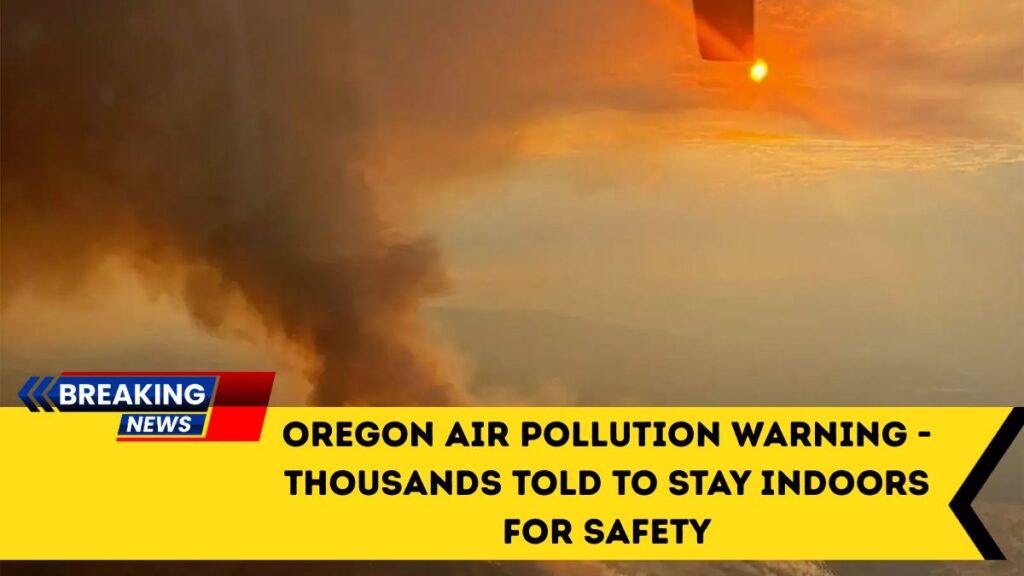Oregon Air Pollution Warning: Thousands of people in Oregon were told to stay indoors on Monday morning because the air outside had become too dangerous to breathe.
The reason for this warning was high levels of fine particle pollution, known as PM2.5, which reached the “unhealthy” level in parts of southern Deschutes County and northern Klamath County, including the city of La Pine and nearby areas along Highway 97.
Officials said that the Environmental Protection Agency (EPA) advised people, especially children, older adults, and those with breathing problems, to avoid going outside for long periods. Others were told to reduce outdoor activity and take more breaks if they needed to be outside.
Why This Matters
Bad air quality can seriously affect people’s health. When the air gets filled with tiny particles, they can easily enter your lungs and even your bloodstream. These particles are called PM2.5, and they come from sources like wildfires, car smoke, and dust.
Experts say that when air pollution reaches “unhealthy” levels, it can cause:
- Breathing problems or coughing
- Chest pain or irregular heartbeat
- Asthma attacks
- Fatigue and dizziness
- Long-term lung and heart diseases
For people who already have health problems, such as asthma or heart conditions, the risk is even higher. That’s why staying indoors can protect you from harmful effects.
Air Quality Index (AQI) Levels
The Air Quality Index (AQI) is used to measure how clean or polluted the air is. It ranges from 0 to over 300, with each range showing how harmful the air can be.
| AQI Range | Color | Category | Health Meaning |
|---|---|---|---|
| 0–50 | Green | Good | Air is clean and safe. |
| 51–100 | Yellow | Moderate | Air is acceptable, but some people may feel slight effects. |
| 101–150 | Orange | Unhealthy for Sensitive Groups | Older adults and children may be affected. |
| 151–200 | Red | Unhealthy | Everyone may start to feel health effects. |
| 201–300 | Purple | Very Unhealthy | Serious health alert for all people. |
| 301+ | Maroon | Hazardous | Emergency conditions; everyone should stay indoors. |
On Monday, parts of Oregon were in the red zone, which means the air was considered “unhealthy.” This is why local authorities and the EPA issued public health warnings.
What Causes PM2.5 Pollution
Fine particle pollution or PM2.5 can come from many sources. In Oregon, it often happens because of wildfires, wood burning, and vehicle emissions. During dry weather, smoke from these sources mixes with the air and forms a thick haze.
These particles are so small that they are nearly invisible, yet they can travel deep into your lungs and cause irritation. If the situation continues for several days, it can make breathing even more difficult and lead to long-term health problems.
What People Should Do
If you live in an area where the air quality is bad, there are some simple steps you can take to protect yourself:
- Stay indoors as much as possible until the air improves.
- Keep doors and windows closed to stop polluted air from coming in.
- Avoid outdoor exercise or heavy physical activity.
- Use air purifiers if available, to keep indoor air clean.
- Drink more water, which helps your body flush out toxins.
- Check the air quality in your area before stepping outside.
If you start feeling symptoms like coughing, shortness of breath, or chest tightness, it’s best to seek medical advice quickly.
Why Staying Inside Helps
Staying inside reduces how much polluted air you breathe. This keeps your lungs and heart safer.
For kids and elderly people, staying indoors during such times can prevent asthma attacks, breathing issues, and tiredness. It also helps you avoid long-term exposure to harmful air.
The air pollution alert in Oregon is a reminder that clean air is essential for good health. When tiny particles like PM2.5 rise to dangerous levels, they can cause serious breathing and heart problems.
Staying indoors, keeping windows shut, and avoiding heavy outdoor work are the best ways to stay safe. Taking small steps like these can protect your health until the air becomes clean again.
Everyone, especially those who are sensitive to pollution, should always monitor local air-quality updates and take action early to stay safe and healthy.
